Voyager 1 Sends Clear Data to NASA for the First Time in Five Months
The farthest spacecraft from Earth had been transmitting nonsense since November, but after an engineering tweak, it finally beamed back a report on its health and status
/https://tf-cmsv2-smithsonianmag-media.s3.amazonaws.com/accounts/headshot/Will-Sullivan-photo.png)
Will Sullivan
Daily Correspondent
:focal(2016x1133:2017x1134)/https://tf-cmsv2-smithsonianmag-media.s3.amazonaws.com/filer_public/32/30/3230d19e-cc50-4905-840c-7f3afeb2a0c3/e1-pia26275-voyager-copy-16.jpg)
For the first time in five months, NASA has received usable data from Voyager 1, the farthest spacecraft from Earth.
The aging probe, which has traveled more than 15 billion miles into space, stopped transmitting science and engineering data on November 14. Instead, it sent NASA a nonsensical stream of repetitive binary code . For months, the agency’s engineers undertook a slow process of trial and error, giving the spacecraft various commands and waiting to see how it responded. Thanks to some creative thinking, the team identified a broken chip on the spacecraft and relocated some of the code that was stored there, according to the agency .
NASA is now receiving data about the health and status of Voyager 1’s engineering systems. The next step is to get the spacecraft to start sending science data again.
“Today was a great day for Voyager 1,” Linda Spilker , a Voyager project scientist at NASA’s Jet Propulsion Laboratory (JPL), said in a statement over the weekend, per CNN ’s Ashley Strickland. “We’re back in communication with the spacecraft. And we look forward to getting science data back.”
Hi, it's me. - V1 https://t.co/jgGFBfxIOe — NASA Voyager (@NASAVoyager) April 22, 2024
Voyager 1 and its companion, Voyager 2, separately launched from Earth in 1977. Between the two of them, the probes have studied all four giant planets in the outer solar system—Jupiter, Saturn, Uranus and Neptune—along with 48 of their moons and the planets’ magnetic fields. The spacecraft observed Saturn’s rings in detail and discovered active volcanoes on Jupiter’s moon Io .
Originally designed for a five-year mission within our solar system, both probes are still operational and chugging along through space, far beyond Pluto’s orbit. In 2012, Voyager 1 became the first human-made object to reach interstellar space, the area between stars. The probe is now about eight times farther from the sun than Uranus is on average.
Over the decades, the Voyager spacecraft have transmitted data collected on their travels back to NASA scientists. But in November, Voyager 1 started sending gibberish .
Engineers determined Voyager 1’s issue was with one of three onboard computers, called the flight data system (FDS), NASA said in a December blog post . While the spacecraft was still receiving and executing commands from Earth, the FDS was not communicating properly with a subsystem called the telemetry modulation unit (TMU). The FDS collects science and engineering data and combines it into a package that the TMU transmits back to Earth.
Since Voyager 1 is so far away, testing solutions to its technical issues requires time—it takes 22.5 hours for commands to reach the probe and another 22.5 hours for Voyager 1’s response to come back.
On March 1, engineers sent a command that coaxed Voyager 1 into sending a readout of the FDS memory, NASA said in a March 13 blog post . From that readout, the team confirmed a small part—about 3 percent—of the system’s memory had been corrupted, NASA said in an April 4 update .
The core of the problem turned out to be a faulty chip hosting some software code and part of the FDS memory. NASA doesn’t know what caused the chip to stop working—it could be that a high-energy particle from space collided with it, or the chip might have just run out of steam after almost 50 years spent hurtling through the cosmos.
“It’s the most serious issue we’ve had since I’ve been the project manager, and it’s scary because you lose communication with the spacecraft,” Suzanne Dodd , Voyager project manager at JPL, told Scientific American ’s Nadia Drake in March.
To receive usable data again, the engineers needed to move the affected code somewhere else that wasn’t broken. But no single location in the FDS memory was large enough to hold all of the code, so the engineers divided it into chunks and stored it in multiple places, per NASA .
The team started with moving the code responsible for sending Voyager’s status reports, sending it to its new location in the FDS memory on April 18. They received confirmation that the strategy worked on April 20, when the first data on the spacecraft’s health since November arrived on Earth.
In the next several weeks, the team will relocate the parts of the FDS software that can start returning science data.
Get the latest stories in your inbox every weekday.
/https://tf-cmsv2-smithsonianmag-media.s3.amazonaws.com/accounts/headshot/Will-Sullivan-photo.png)
Will Sullivan | | READ MORE
Will Sullivan is a science writer based in Washington, D.C. His work has appeared in Inside Science and NOVA Next .


Voyager Stories
Stay up-to-date with the latest content from the Voyager mission team as the spacecraft travel farther into interstellar space.
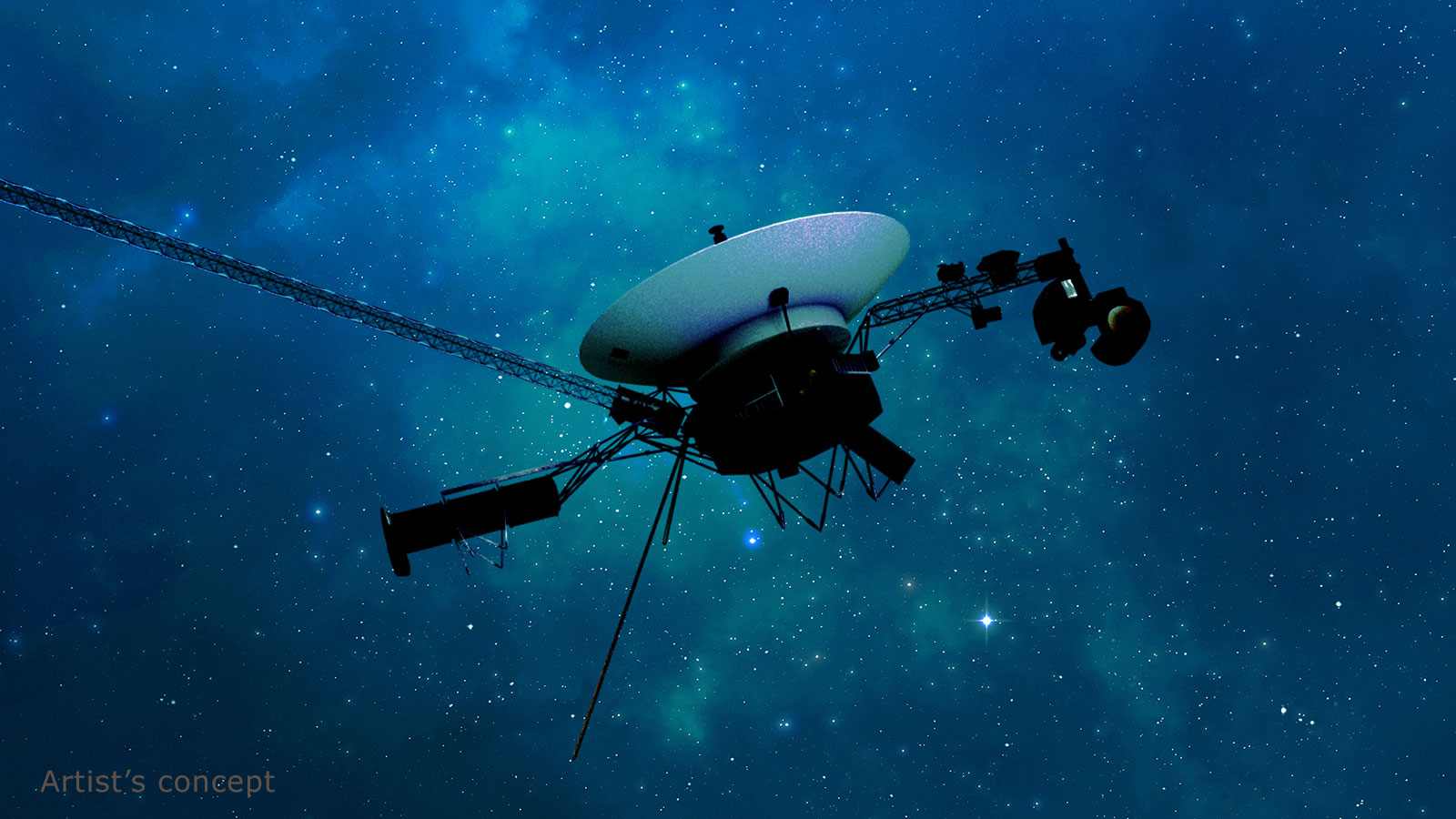
NASA’s Voyager Team Focuses on Software Patch, Thrusters
The efforts should help extend the lifetimes of the agency’s interstellar explorers. Engineers for NASA’s Voyager mission are taking steps to help make sure both spacecraft, launched in 1977, continue to explore interstellar space for years to come. One effort…

NASA Mission Update: Voyager 2 Communications Pause
Once the spacecraft’s antenna is realigned with Earth, communications should resume.
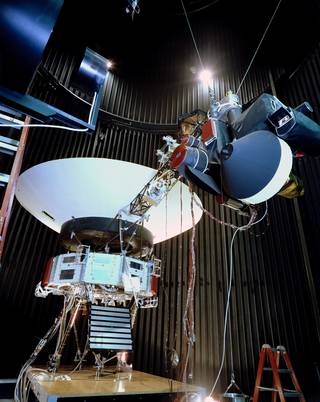
NASA’s Voyager Will Do More Science With New Power Strategy
The plan will keep Voyager 2’s science instruments turned on a few years longer than previously anticipated, enabling yet more revelations from interstellar space.
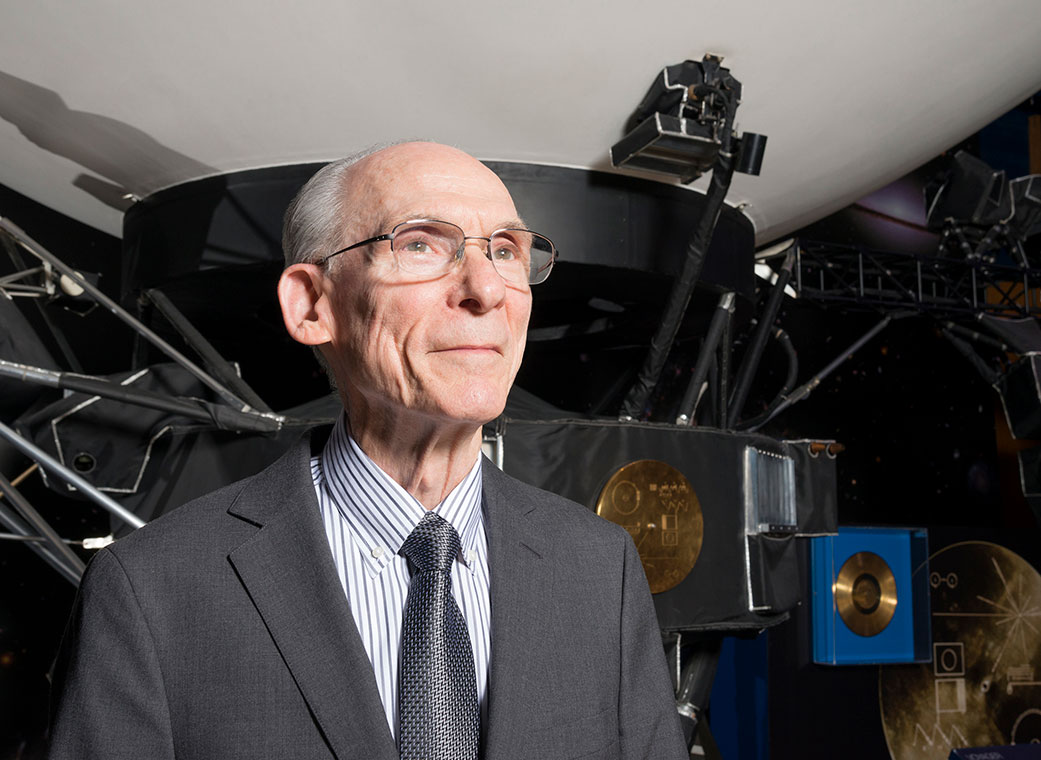
Edward Stone Retires After 50 Years as NASA Voyager’s Project Scientist
Stone’s remarkable tenure on NASA’s longest-operating mission spans decades of historic discoveries and firsts. Edward Stone has retired as the project scientist for NASA’s Voyager mission a half-century after taking on the role. Stone accepted scientific leadership of the historic…
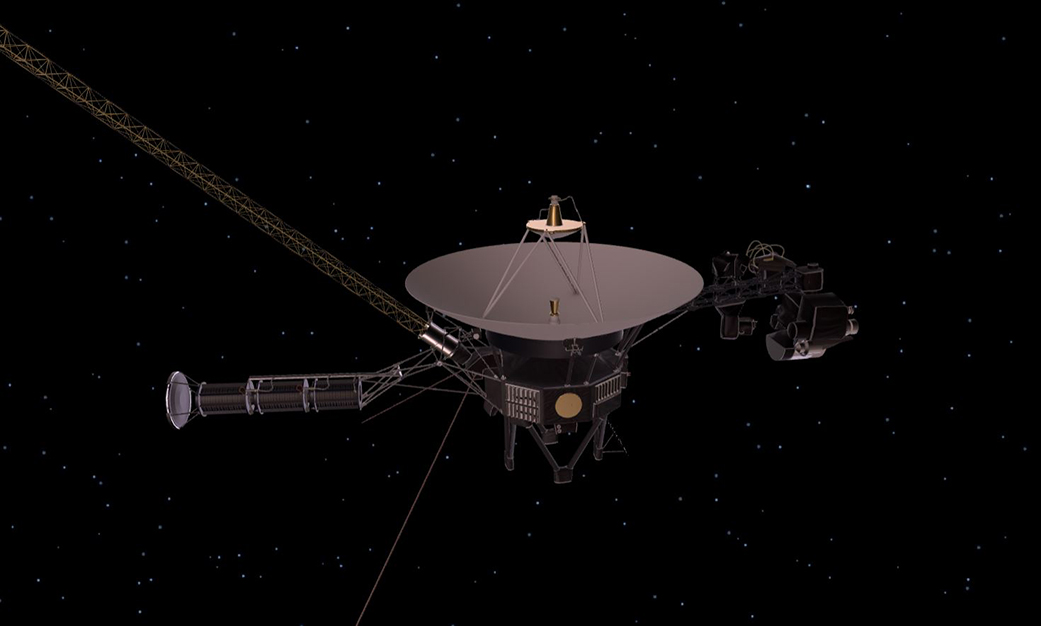
Engineers Solve Data Glitch on NASA’s Voyager 1
A critical system aboard the probe was sending garbled data about its status. Engineers have fixed the issue but are still seeking the root cause. Engineers have repaired an issue affecting data from NASA’s Voyager 1 spacecraft. Earlier this year,…
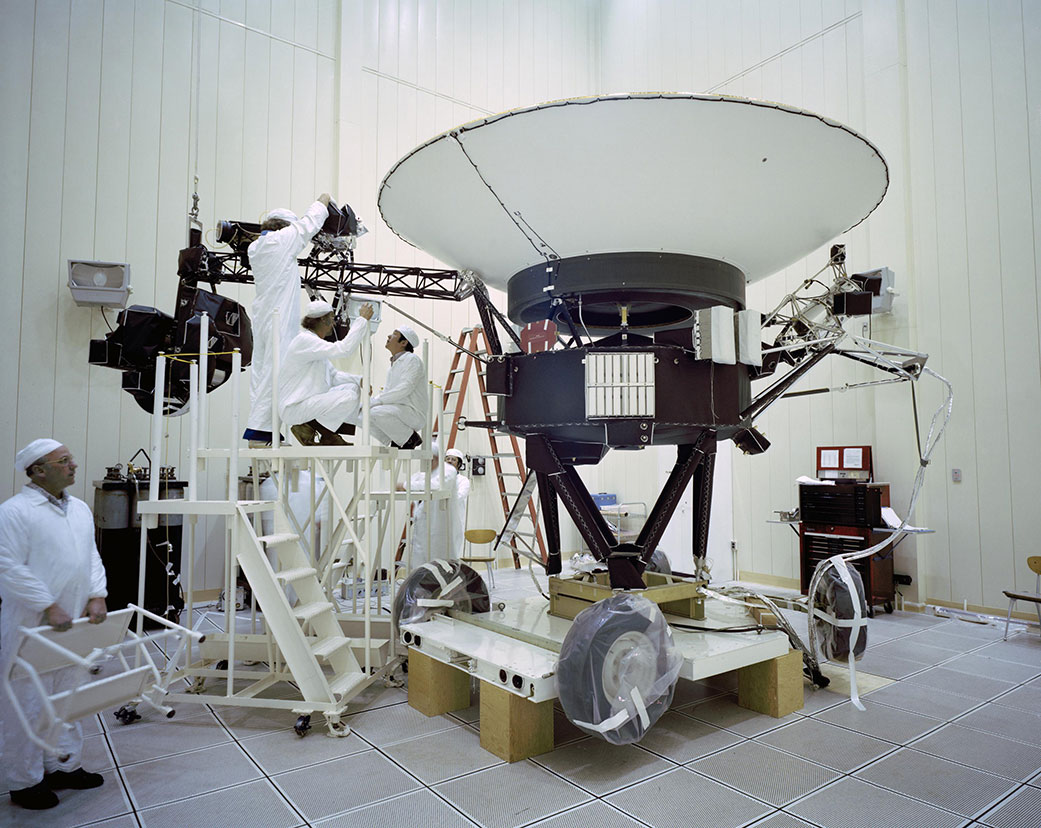
Voyager, NASA’s Longest-Lived Mission, Logs 45 Years in Space
Launched in 1977, the twin Voyager probes are NASA’s longest-operating mission and the only spacecraft ever to explore interstellar space. NASA’s twin Voyager probes have become, in some ways, time capsules of their era: They each carry an eight-track tape…
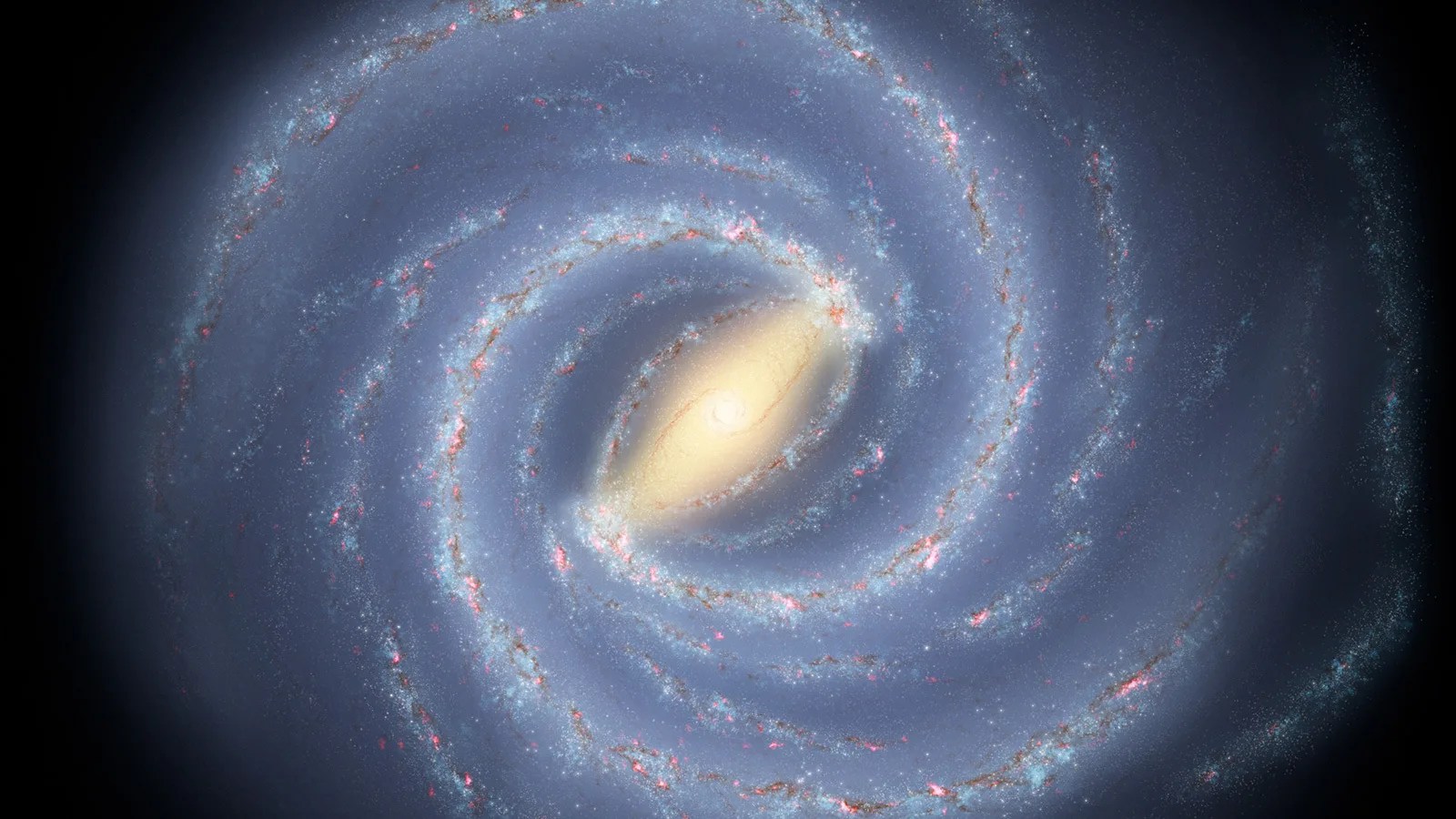
10 Things: Going Interstellar
Humanity’s great leap into interstellar space – the space between the stars – has begun. Here are 10 things we’ve learned about going interstellar.

Suggested Searches
- Climate Change
- Expedition 64
- Mars perseverance
- SpaceX Crew-2
- International Space Station
- View All Topics A-Z
Humans in Space
Earth & climate, the solar system, the universe, aeronautics, learning resources, news & events.

NASA-Led Study Provides New Global Accounting of Earth’s Rivers

NASA’s Hubble Pauses Science Due to Gyro Issue

NASA’s Optical Comms Demo Transmits Data Over 140 Million Miles
- Search All NASA Missions
- A to Z List of Missions
- Upcoming Launches and Landings
- Spaceships and Rockets
- Communicating with Missions
- James Webb Space Telescope
- Hubble Space Telescope
- Why Go to Space
- Astronauts Home
- Commercial Space
- Destinations
- Living in Space
- Explore Earth Science
- Earth, Our Planet
- Earth Science in Action
- Earth Multimedia
- Earth Science Researchers
- Pluto & Dwarf Planets
- Asteroids, Comets & Meteors
- The Kuiper Belt
- The Oort Cloud
- Skywatching
- The Search for Life in the Universe
- Black Holes
- The Big Bang
- Dark Energy & Dark Matter
- Earth Science
- Planetary Science
- Astrophysics & Space Science
- The Sun & Heliophysics
- Biological & Physical Sciences
- Lunar Science
- Citizen Science
- Astromaterials
- Aeronautics Research
- Human Space Travel Research
- Science in the Air
- NASA Aircraft
- Flight Innovation
- Supersonic Flight
- Air Traffic Solutions
- Green Aviation Tech
- Drones & You
- Technology Transfer & Spinoffs
- Space Travel Technology
- Technology Living in Space
- Manufacturing and Materials
- Science Instruments
- For Kids and Students
- For Educators
- For Colleges and Universities
- For Professionals
- Science for Everyone
- Requests for Exhibits, Artifacts, or Speakers
- STEM Engagement at NASA
- NASA's Impacts
- Centers and Facilities
- Directorates
- Organizations
- People of NASA
- Internships
- Our History
- Doing Business with NASA
- Get Involved
- Aeronáutica
- Ciencias Terrestres
- Sistema Solar
- All NASA News
- Video Series on NASA+
- Newsletters
- Social Media
- Media Resources
- Upcoming Launches & Landings
- Virtual Events
- Sounds and Ringtones
- Interactives
- STEM Multimedia

Correction and Clarification of C.26 Rapid Mission Design Studies for Mars Sample Return

NASA’s Commercial Partners Deliver Cargo, Crew for Station Science

NASA Shares Lessons of Human Systems Integration with Industry

Work Underway on Large Cargo Landers for NASA’s Artemis Moon Missions

NASA’s ORCA, AirHARP Projects Paved Way for PACE to Reach Space

Amendment 11: Physical Oceanography not solicited in ROSES-2024

Why is Methane Seeping on Mars? NASA Scientists Have New Ideas

Mars Science Laboratory: Curiosity Rover

Hubble Spots a Magnificent Barred Galaxy

NASA’s Chandra Releases Doubleheader of Blockbuster Hits

Explore the Universe with the First E-Book from NASA’s Fermi

NASA Grant Brings Students at Underserved Institutions to the Stars

NASA Photographer Honored for Thrilling Inverted In-Flight Image

NASA’s Ingenuity Mars Helicopter Team Says Goodbye … for Now

NASA Langley Team to Study Weather During Eclipse Using Uncrewed Vehicles

NASA Data Helps Beavers Build Back Streams

NASA’s Near Space Network Enables PACE Climate Mission to ‘Phone Home’

Washington State High Schooler Wins 2024 NASA Student Art Contest

NASA STEM Artemis Moon Trees

Kiyun Kim: From Intern to Accessibility Advocate

Diez maneras en que los estudiantes pueden prepararse para ser astronautas

Astronauta de la NASA Marcos Berríos

Resultados científicos revolucionarios en la estación espacial de 2023
Nasa’s voyager spacecraft still reaching for the stars after 40 years.

Humanity’s farthest and longest-lived spacecraft, Voyager 1 and 2, achieve 40 years of operation and exploration this August and September. Despite their vast distance, they continue to communicate with NASA daily, still probing the final frontier.
Their story has not only impacted generations of current and future scientists and engineers, but also Earth’s culture, including film, art and music. Each spacecraft carries a Golden Record of Earth sounds, pictures and messages. Since the spacecraft could last billions of years, these circular time capsules could one day be the only traces of human civilization.
“I believe that few missions can ever match the achievements of the Voyager spacecraft during their four decades of exploration,” said Thomas Zurbuchen, associate administrator for NASA’s Science Mission Directorate (SMD) at NASA Headquarters. “They have educated us to the unknown wonders of the universe and truly inspired humanity to continue to explore our solar system and beyond.”
The Voyagers have set numerous records in their unparalleled journeys. In 2012, Voyager 1, which launched on Sept. 5, 1977, became the only spacecraft to have entered interstellar space . Voyager 2, launched on Aug. 20, 1977, is the only spacecraft to have flown by all four outer planets – Jupiter, Saturn, Uranus and Neptune. Their numerous planetary encounters include discovering the first active volcanoes beyond Earth, on Jupiter’s moon Io ; hints of a subsurface ocean on Jupiter’s moon Europa ; the most Earth-like atmosphere in the solar system, on Saturn’s moon Titan ; the jumbled-up, icy moon Miranda at Uranus; and icy-cold geysers on Neptune’s moon Triton .
Though the spacecraft have left the planets far behind – and neither will come remotely close to another star for 40,000 years – the two probes still send back observations about conditions where our Sun’s influence diminishes and interstellar space begins.
Voyager 1, now almost 13 billion miles from Earth, travels through interstellar space northward out of the plane of the planets. The probe has informed researchers that cosmic rays, atomic nuclei accelerated to nearly the speed of light, are as much as four times more abundant in interstellar space than in the vicinity of Earth. This means the heliosphere, the bubble-like volume containing our solar system’s planets and solar wind, effectively acts as a radiation shield for the planets. Voyager 1 also hinted that the magnetic field of the local interstellar medium is wrapped around the heliosphere.
Voyager 2, now almost 11 billion miles from Earth, travels south and is expected to enter interstellar space in the next few years. The different locations of the two Voyagers allow scientists to compare right now two regions of space where the heliosphere interacts with the surrounding interstellar medium using instruments that measure charged particles, magnetic fields, low-frequency radio waves and solar wind plasma. Once Voyager 2 crosses into the interstellar medium, they will also be able to sample the medium from two different locations simultaneously.
“None of us knew, when we launched 40 years ago, that anything would still be working, and continuing on this pioneering journey,” said Ed Stone, Voyager project scientist based at Caltech in Pasadena, California. “The most exciting thing they find in the next five years is likely to be something that we didn’t know was out there to be discovered.”
The twin Voyagers have been cosmic overachievers, thanks to the foresight of mission designers. By preparing for the radiation environment at Jupiter, the harshest of all planets in our solar system, the spacecraft were well equipped for their subsequent journeys. Both Voyagers are equipped with long-lasting power supplies, as well as redundant systems that allow the spacecraft to switch to backup systems autonomously when necessary. Each Voyager carries three radioisotope thermoelectric generators, devices that use the heat energy generated from the decay of plutonium-238 – only half of it will be gone after 88 years.
Space is almost empty, so the Voyagers are not at a significant level of risk of bombardment by large objects. However, Voyager 1’s interstellar space environment is not a complete void. It’s filled with clouds of dilute material remaining from stars that exploded as supernovae millions of years ago. This material doesn’t pose a danger to the spacecraft, but is a key part of the environment that the Voyager mission is helping scientists study and characterize.
Because the Voyagers’ power decreases by four watts per year, engineers are learning how to operate the spacecraft under ever-tighter power constraints. And to maximize the Voyagers’ life spans, they also have to consult documents written decades earlier describing commands and software, in addition to the expertise of former Voyager engineers.
“The technology is many generations old, and it takes someone with 1970s design experience to understand how the spacecraft operate and what updates can be made to permit them to continue operating today and into the future,” said Suzanne Dodd, Voyager project manager based at NASA’s Jet Propulsion Laboratory (JPL) in Pasadena, California.
Team members estimate they will have to turn off the last science instrument by 2030. However, even after the spacecraft go silent, they’ll continue on their trajectories at their present speed of more than 30,000 mph (48,280 kilometers per hour), completing an orbit within the Milky Way every 225 million years.
The Voyager spacecraft were built by JPL, which continues to operate both. The Voyager missions are part of the NASA Heliophysics System Observatory, sponsored by the Heliophysics Division of SMD.
For more information about the Voyager spacecraft, visit:
Dwayne Brown / Laurie Cantillo Headquarters, Washington 202-358-1726 / 202-358-1077 [email protected] / [email protected] Elizabeth Landau / Jia-Rui Cook Jet Propulsion Laboratory, Pasadena, Calif. 818-354-6425 / 818-354-0724 [email protected] / [email protected]

Suggested Searches
- Climate Change
- Expedition 64
- Mars perseverance
- SpaceX Crew-2
- International Space Station
- View All Topics A-Z
Humans in Space
Earth & climate, the solar system, the universe, aeronautics, learning resources, news & events.

NASA-Led Study Provides New Global Accounting of Earth’s Rivers

NASA’s Hubble Pauses Science Due to Gyro Issue

NASA’s Optical Comms Demo Transmits Data Over 140 Million Miles
- Search All NASA Missions
- A to Z List of Missions
- Upcoming Launches and Landings
- Spaceships and Rockets
- Communicating with Missions
- James Webb Space Telescope
- Hubble Space Telescope
- Why Go to Space
- Astronauts Home
- Commercial Space
- Destinations
- Living in Space
- Explore Earth Science
- Earth, Our Planet
- Earth Science in Action
- Earth Multimedia
- Earth Science Researchers
- Pluto & Dwarf Planets
- Asteroids, Comets & Meteors
- The Kuiper Belt
- The Oort Cloud
- Skywatching
- The Search for Life in the Universe
- Black Holes
- The Big Bang
- Dark Energy & Dark Matter
- Earth Science
- Planetary Science
- Astrophysics & Space Science
- The Sun & Heliophysics
- Biological & Physical Sciences
- Lunar Science
- Citizen Science
- Astromaterials
- Aeronautics Research
- Human Space Travel Research
- Science in the Air
- NASA Aircraft
- Flight Innovation
- Supersonic Flight
- Air Traffic Solutions
- Green Aviation Tech
- Drones & You
- Technology Transfer & Spinoffs
- Space Travel Technology
- Technology Living in Space
- Manufacturing and Materials
- Science Instruments
- For Kids and Students
- For Educators
- For Colleges and Universities
- For Professionals
- Science for Everyone
- Requests for Exhibits, Artifacts, or Speakers
- STEM Engagement at NASA
- NASA's Impacts
- Centers and Facilities
- Directorates
- Organizations
- People of NASA
- Internships
- Our History
- Doing Business with NASA
- Get Involved
- Aeronáutica
- Ciencias Terrestres
- Sistema Solar
- All NASA News
- Video Series on NASA+
- Newsletters
- Social Media
- Media Resources
- Upcoming Launches & Landings
- Virtual Events
- Sounds and Ringtones
- Interactives
- STEM Multimedia

Correction and Clarification of C.26 Rapid Mission Design Studies for Mars Sample Return

NASA’s Commercial Partners Deliver Cargo, Crew for Station Science

NASA Shares Lessons of Human Systems Integration with Industry

Work Underway on Large Cargo Landers for NASA’s Artemis Moon Missions

NASA’s ORCA, AirHARP Projects Paved Way for PACE to Reach Space

Amendment 11: Physical Oceanography not solicited in ROSES-2024

Why is Methane Seeping on Mars? NASA Scientists Have New Ideas

Mars Science Laboratory: Curiosity Rover

Hubble Spots a Magnificent Barred Galaxy

NASA’s Chandra Releases Doubleheader of Blockbuster Hits

Explore the Universe with the First E-Book from NASA’s Fermi

NASA Grant Brings Students at Underserved Institutions to the Stars

NASA Photographer Honored for Thrilling Inverted In-Flight Image

NASA’s Ingenuity Mars Helicopter Team Says Goodbye … for Now

NASA Langley Team to Study Weather During Eclipse Using Uncrewed Vehicles

NASA Data Helps Beavers Build Back Streams

NASA’s Near Space Network Enables PACE Climate Mission to ‘Phone Home’

Washington State High Schooler Wins 2024 NASA Student Art Contest

NASA STEM Artemis Moon Trees

Kiyun Kim: From Intern to Accessibility Advocate

Diez maneras en que los estudiantes pueden prepararse para ser astronautas

Astronauta de la NASA Marcos Berríos

Resultados científicos revolucionarios en la estación espacial de 2023
To view this video please enable JavaScript, and consider upgrading to a web browser that supports HTML5 video
The Von Kármán Lecture Series: Voyager: 45 Years in Space
As the twin Voyager spacecraft approach their 45th anniversary, we take a look at where the mission has been, what they’ve taught us, and where they go from here. In […]
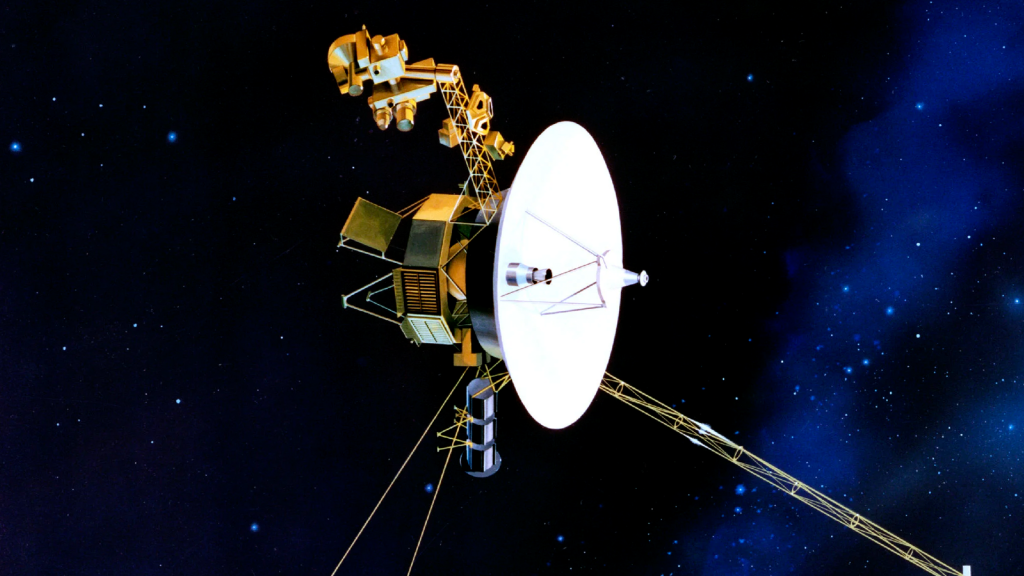
- Open Video Player
- WhatsApp https://plus.nasa.gov/video/voyager-45-years-in-space/ Copy URL to clipboard> Share
As the twin Voyager spacecraft approach their 45th anniversary, we take a look at where the mission has been, what they’ve taught us, and where they go from here. In this conversation with Suzanne Dodd, Voyager Project Manager, we’ll discuss how Voyager came to be, highlight some of the major discoveries, and hear stories about this mission that has captured the public’s attention for years.
The Von Kármán Lecture Series: How Do Missions Get Formed?
The von kármán lecture series: boldly go where no robots have gone before, the von kármán lecture series: surface mineral dust source investigation (emit) mission, the von kármán lecture series: how we find, name, and investigate exoplanets.
- Page Last Updated: Apr 26, 2024
- Responsible NASA Official: Rebecca Sirmons
After months of silence, Voyager 1 has returned NASA’s calls

- Show more sharing options
- Copy Link URL Copied!
For the last five months, it seemed very possible that a 46-year-old conversation had finally reached its end.
Since its launch from Kennedy Space Center on Sept. 5, 1977, NASA’s Voyager 1 spacecraft has diligently sent regular updates to Earth on the health of its systems and data collected from its onboard instruments.
But in November, the craft went quiet.
Voyager 1 is now some 15 billion miles away from Earth. Somewhere in the cold interstellar space between our sun and the closest stars, its flight data system stopped communicating with the part of the probe that allows it to send signals back to Earth. Engineers at the Jet Propulsion Laboratory in La Cañada Flintridge could tell that Voyager 1 was getting its messages, but nothing was coming back.
“We’re to the point where the hardware is starting to age,” said Linda Spilker, the project scientist for the Voyager mission. “It’s like working on an antique car, from 15 billion miles away.”
Week after week, engineers sent troubleshooting commands to the spacecraft, each time patiently waiting the 45 hours it takes to get a response here on Earth — 22.5 hours traveling at the speed of light to reach the probe, and 22.5 hours back.

Science & Medicine

This space artist created the Golden Record and changed the way we see the universe
Space artist Jon Lomberg has produced work that attempts to visualize what we can’t truly see, and to communicate with creatures we can’t yet imagine.
July 26, 2023
By March, the team had figured out that a memory chip that stored some of the flight data system’s software code had failed, turning the craft’s outgoing communications into gibberish.
A long-distance repair wasn’t possible. There wasn’t enough space anywhere in the system to shift the code in its entirety. So after manually reviewing the code line by line, engineers broke it up and tucked the pieces into the available slots of memory.
They sent a command to Voyager on Thursday. In the early morning hours Saturday, the team gathered around a conference table at JPL: laptops open, coffee and boxes of doughnuts in reach.
At 6:41 a.m., data from the craft showed up on their screens. The fix had worked .
“We went from very quiet and just waiting patiently to cheers and high-fives and big smiles and sighs of relief,” Spilker said. “I’m very happy to once again have a meaningful conversation with Voyager 1.”
Voyager 1 is one of two identical space probes. Voyager 2, launched two weeks before Voyager 1, is now about 13 billion miles from Earth, the two crafts’ trajectories having diverged somewhere around Saturn. (Voyager 2 continued its weekly communications uninterrupted during Voyager 1’s outage.)

Space shuttle Endeavour is lifted into the sky, takes final position as star of new museum wing
A shrink-wrapped Endeavour was hoisted and then carefully placed in its final location Tuesday at the still-under-construction Samuel Oschin Air and Space Center.
Jan. 30, 2024
They are the farthest-flung human-made objects in the universe, having traveled farther from their home planet than anything else this species has built. The task of keeping communications going grows harder with each passing day. Every 24 hours, Voyager 1 travels 912,000 miles farther away from us. As that distance grows, the signal becomes slower and weaker.
When the probe visited Jupiter in 1979, it was sending back data at a rate of 115.2 kilobits per second, Spilker said. Today, 45 years and more than 14 billion miles later, data come back at a rate of 40 bits per second.
The team is cautiously optimistic that the probes will stay in contact for three more years, long enough to celebrate the mission’s 50th anniversary in 2027, Spilker said. They could conceivably last until the 2030s.
The conversation can’t last forever. Microscopic bits of silica keep clogging up the thrusters that keep the probes’ antennas pointed toward Earth, which could end communications. The power is running low. Eventually, the day will come when both Voyagers stop transmitting data to Earth, and the first part of their mission ends.
But on the day each craft goes quiet, they begin a new era, one that could potentially last far longer. Each probe is equipped with a metallic album cover containing a Golden Record , a gold-plated copper disk inscribed with sounds and images meant to describe the species that built the Voyagers and the planet they came from.
Erosion in space is negligible; the images could be readable for another billion years or more. Should any other intelligent life form encounter one of the Voyager probes and have a means of retrieving the data from the record, they will at the very least have a chance to figure out who sent them — even if our species is by that time long gone.
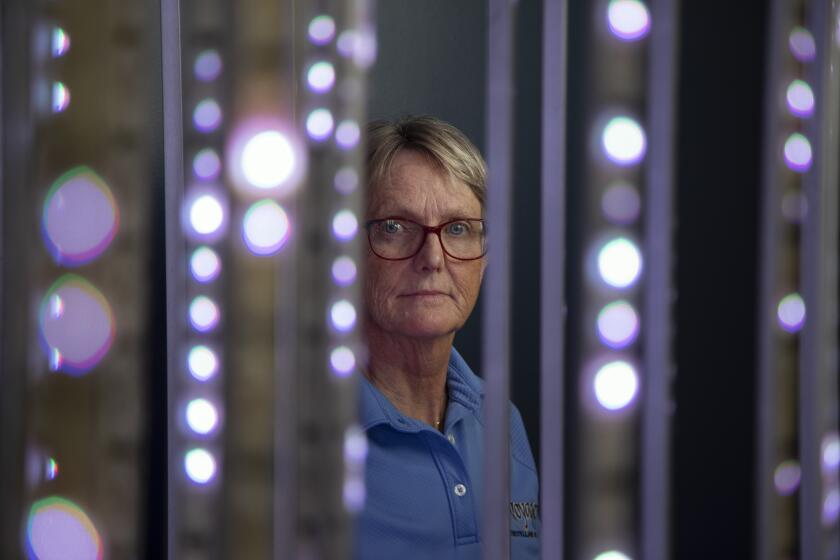
JPL tries to keep Voyager space probes from disconnecting the world’s longest phone call
Keeping in touch with NASA’s two aging Voyager spacecraft is getting harder to do as they get farther away and their power sources dwindle.
Sept. 3, 2022
More to Read

Too expensive, too slow: NASA asks for help with JPL’s Mars Sample Return mission
April 15, 2024

NASA’s attempt to bring home part of Mars is unprecedented. The mission’s problems are not
March 25, 2024
Budget deal for NASA offers glimmer of hope for JPL’s Mars Sample Return mission
March 6, 2024

Corinne Purtill is a science and medicine reporter for the Los Angeles Times. Her writing on science and human behavior has appeared in the New Yorker, the New York Times, Time Magazine, the BBC, Quartz and elsewhere. Before joining The Times, she worked as the senior London correspondent for GlobalPost (now PRI) and as a reporter and assignment editor at the Cambodia Daily in Phnom Penh. She is a native of Southern California and a graduate of Stanford University.
More From the Los Angeles Times

Person stabbed after argument spills out of L.A. Metro bus, police say
April 26, 2024

Accomplice in shooting death of 6-year-old Aidan Leos pleads guilty, sentenced to time served
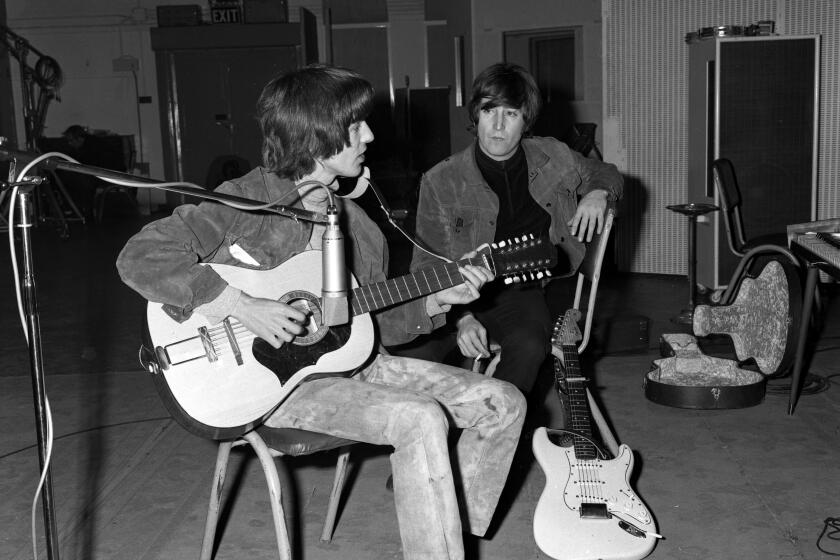
An NDA and a prayer to John Lennon’s ghost: How an L.A. guitar repairman fixed a Beatles relic

Kaiser Permanente notifies 13.4 million members of data breach. City of Hope also reported breach
share this!
April 22, 2024
This article has been reviewed according to Science X's editorial process and policies . Editors have highlighted the following attributes while ensuring the content's credibility:
fact-checked
trusted source
NASA's Voyager 1 resumes sending engineering updates to Earth

For the first time since November, NASA's Voyager 1 spacecraft is returning usable data about the health and status of its onboard engineering systems. The next step is to enable the spacecraft to begin returning science data again. The probe and its twin, Voyager 2, are the only spacecraft to ever fly in interstellar space (the space between stars).
Voyager 1 stopped sending readable science and engineering data back to Earth on Nov. 14, 2023, even though mission controllers could tell the spacecraft was still receiving their commands and otherwise operating normally. In March, the Voyager engineering team at NASA's Jet Propulsion Laboratory in Southern California confirmed that the issue was tied to one of the spacecraft's three onboard computers, called the flight data subsystem (FDS). The FDS is responsible for packaging the science and engineering data before it's sent to Earth.
The team discovered that a single chip responsible for storing a portion of the FDS memory—including some of the FDS computer's software code—isn't working. The loss of that code rendered the science and engineering data unusable. Unable to repair the chip, the team decided to place the affected code elsewhere in the FDS memory. But no single location is large enough to hold the section of code in its entirety.
So they devised a plan to divide the affected code into sections and store those sections in different places in the FDS. To make this plan work, they also needed to adjust those code sections to ensure, for example, that they all still function as a whole. Any references to the location of that code in other parts of the FDS memory needed to be updated as well.

The team started by singling out the code responsible for packaging the spacecraft's engineering data. They sent it to its new location in the FDS memory on April 18. A radio signal takes about 22.5 hours to reach Voyager 1, which is over 15 billion miles (24 billion kilometers) from Earth, and another 22.5 hours for a signal to come back to Earth. When the mission flight team heard back from the spacecraft on April 20, they saw that the modification had worked: For the first time in five months, they were able to check the health and status of the spacecraft.
During the coming weeks, the team will relocate and adjust the other affected portions of the FDS software. These include the portions that will start returning science data.
Voyager 2 continues to operate normally. Launched over 46 years ago, the twin Voyager spacecraft are the longest-running and most distant spacecraft in history. Before the start of their interstellar exploration, both probes flew by Saturn and Jupiter, and Voyager 2 flew by Uranus and Neptune.
Provided by NASA
Explore further
Feedback to editors

Optical barcodes expand range of high-resolution sensor
10 hours ago

Ridesourcing platforms thrive on socio-economic inequality, say researchers

Did Vesuvius bury the home of the first Roman emperor?
11 hours ago

Florida dolphin found with highly pathogenic avian flu: Report

A new way to study and help prevent landslides

New algorithm cuts through 'noisy' data to better predict tipping points

Researchers reconstruct landscapes that greeted the first humans in Australia around 65,000 years ago

High-precision blood glucose level prediction achieved by few-molecule reservoir computing
12 hours ago

Enhancing memory technology: Multiferroic nanodots for low-power magnetic storage

Researchers advance detection of gravitational waves to study collisions of neutron stars and black holes
Relevant physicsforums posts, our beautiful universe - photos and videos.
Apr 25, 2024
Solar Activity and Space Weather Update thread
'devil' comet visible tonight 21.04.24, waves in space, documenting the setup of my new telescope.
Apr 24, 2024
What did I capture?
Apr 23, 2024
More from Astronomy and Astrophysics
Related Stories

Engineers working to resolve issue with Voyager 1 computer
Dec 13, 2023

NASA hears signal from Voyager 2 spacecraft after mistakenly cutting contact
Aug 1, 2023

NASA listens for Voyager 2 spacecraft after wrong command cuts contact
Jul 31, 2023

NASA's Voyager team focuses on software patch, thrusters
Oct 20, 2023

NASA's Voyager will do more science with new power strategy
Apr 27, 2023

Engineers investigating NASA's Voyager 1 telemetry data
May 18, 2022
Recommended for you

Japan's moon lander wasn't built to survive a weekslong lunar night. It's still going after 3

Simulated microgravity affects sleep and physiological rhythms, study finds
Apr 22, 2024

'Tube map' around planets and moons made possible by knot theory
Apr 17, 2024

NASA's Ingenuity Mars helicopter team says goodbye—for now

NASA confirms mystery object that crashed through roof of Florida home came from space station
Apr 16, 2024

NASA is seeking a faster, cheaper way to bring Mars samples to Earth
Let us know if there is a problem with our content.
Use this form if you have come across a typo, inaccuracy or would like to send an edit request for the content on this page. For general inquiries, please use our contact form . For general feedback, use the public comments section below (please adhere to guidelines ).
Please select the most appropriate category to facilitate processing of your request
Thank you for taking time to provide your feedback to the editors.
Your feedback is important to us. However, we do not guarantee individual replies due to the high volume of messages.
E-mail the story
Your email address is used only to let the recipient know who sent the email. Neither your address nor the recipient's address will be used for any other purpose. The information you enter will appear in your e-mail message and is not retained by Phys.org in any form.
Newsletter sign up
Get weekly and/or daily updates delivered to your inbox. You can unsubscribe at any time and we'll never share your details to third parties.
More information Privacy policy
Donate and enjoy an ad-free experience
We keep our content available to everyone. Consider supporting Science X's mission by getting a premium account.
E-mail newsletter
- Election 2024
- Entertainment
- Newsletters
- Photography
- Personal Finance
- AP Investigations
- AP Buyline Personal Finance
- AP Buyline Shopping
- Press Releases
- Israel-Hamas War
- Russia-Ukraine War
- Global elections
- Asia Pacific
- Latin America
- Middle East
- Election Results
- Delegate Tracker
- AP & Elections
- Auto Racing
- 2024 Paris Olympic Games
- Movie reviews
- Book reviews
- Personal finance
- Financial Markets
- Business Highlights
- Financial wellness
- Artificial Intelligence
- Social Media
NASA hears from Voyager 1, the most distant spacecraft from Earth, after months of quiet
This illustration provided by NASA depicts Voyager 1. The most distant spacecraft from Earth stopped sending back understandable data in November 2023. Flight controllers traced the blank communication to a bad computer chip and rearranged the spacecraft’s coding to work around the trouble. In mid-April 2024, NASA’s Jet Propulsion Laboratory declared success after receiving good engineering updates. The team is still working to restore transmission of the science data. (NASA via AP)
- Copy Link copied
CAPE CANAVERAL, Fla. (AP) — NASA has finally heard back from Voyager 1 again in a way that makes sense.
The most distant spacecraft from Earth stopped sending back understandable data last November. Flight controllers traced the blank communication to a bad computer chip and rearranged the spacecraft’s coding to work around the trouble.
NASA’s Jet Propulsion Laboratory in Southern California declared success after receiving good engineering updates late last week. The team is still working to restore transmission of the science data.
It takes 22 1/2 hours to send a signal to Voyager 1, more than 15 billion miles (24 billion kilometers) away in interstellar space. The signal travel time is double that for a round trip.
Contact was never lost, rather it was like making a phone call where you can’t hear the person on the other end, a JPL spokeswoman said Tuesday.
Launched in 1977 to study Jupiter and Saturn, Voyager 1 has been exploring interstellar space — the space between star systems — since 2012. Its twin, Voyager 2, is 12.6 billion miles (20 billion kilometers) away and still working fine.
The Associated Press Health and Science Department receives support from the Howard Hughes Medical Institute’s Science and Educational Media Group. The AP is solely responsible for all content.
- Skip to main content
- Keyboard shortcuts for audio player
Well, hello, Voyager 1! The venerable spacecraft is once again making sense

Nell Greenfieldboyce

Members of the Voyager team celebrate at NASA's Jet Propulsion Laboratory after receiving data about the health and status of Voyager 1 for the first time in months. NASA/JPL-Caltech hide caption
Members of the Voyager team celebrate at NASA's Jet Propulsion Laboratory after receiving data about the health and status of Voyager 1 for the first time in months.
NASA says it is once again able to get meaningful information back from the Voyager 1 probe, after months of troubleshooting a glitch that had this venerable spacecraft sending home messages that made no sense.
The Voyager 1 and Voyager 2 probes launched in 1977 on a mission to study Jupiter and Saturn but continued onward through the outer reaches of the solar system. In 2012, Voyager 1 became the first spacecraft to enter interstellar space, the previously unexplored region between the stars. (Its twin, traveling in a different direction, followed suit six years later.)
Voyager 1 had been faithfully sending back readings about this mysterious new environment for years — until November, when its messages suddenly became incoherent .

NASA's Voyager 1 spacecraft is talking nonsense. Its friends on Earth are worried
It was a serious problem that had longtime Voyager scientists worried that this historic space mission wouldn't be able to recover. They'd hoped to be able to get precious readings from the spacecraft for at least a few more years, until its power ran out and its very last science instrument quit working.
For the last five months, a small team at NASA's Jet Propulsion Laboratory in California has been working to fix it. The team finally pinpointed the problem to a memory chip and figured out how to restore some essential software code.
"When the mission flight team heard back from the spacecraft on April 20, they saw that the modification worked: For the first time in five months, they have been able to check the health and status of the spacecraft," NASA stated in an update.
The usable data being returned so far concerns the workings of the spacecraft's engineering systems. In the coming weeks, the team will do more of this software repair work so that Voyager 1 will also be able to send science data, letting researchers once again see what the probe encounters as it journeys through interstellar space.

After a 12.3 billion-mile 'shout,' NASA regains full contact with Voyager 2
- interstellar mission
Voyager Project Information
Not fare well, But fare forward, Voyagers. -- T. S. Eliot, The Dry Salvages
The last two spacecraft of NASA's Mariner series, Voyager 1 and 2 were the first in that series to be sent to explore the outer solar system. Preceeded by the Pioneer 10 and 11 missions, Voyager 1 and 2 were to make studies of Jupiter and Saturn, their satellites, and their magnetospheres as well as studies of the interplanetary medium. An option designed into the Voyager 2 trajectory, and ultimately exercised, would direct it toward Uranus and Neptune to perform similar studies.
Although launched sixteen days after Voyager 2, Voyager 1's trajectory was a faster path, arriving at Jupiter in March of 1979. Voyager 2 arrived about four months later in July 1979. Both spacecraft were then directed on to Saturn with arrival times in November 1980 (Voyager 1) and August 1981 (Voyager 2). Voyager 2 was then diverted to the remaining gas giants, Uranus (January 1986) and Neptune (August 1989). A more detailed table specifying the closest approach distances/times for these encounters is available.
Data collected by Voyager 1 and 2 were not confined to the periods surrounding encounters with the outer gas giants, with the various fields and particles experiments and the ultraviolet spectrometer collecting data nearly continuously during the interplanetary cruise phases of the mission. Data collection continues as the renamed Voyager Interstellar Mission searches for the edge of the solar wind's influence (the heliopause) and exits the solar system.
Some scientific results of the Voyager mission
A comprehensive list of the achievements of Voyager 1 and 2 would be so extensive that space doesn't permit. Here, then, are a (very) few results that would rank near the top of many such lists.
- Discovery of the Uranian and Neptunian magnetospheres, both of them highly inclined and offset from the planets' rotational axes, suggesting their sources are significantly different from other magnetospheres.
- The Voyagers found 22 new satellites: 3 at Jupiter, 3 at Saturn, 10 at Uranus, and 6 at Neptune.
- Io was found to have active volcanism, the only solar system body other than the Earth to be so confirmed. Triton was found to have active geyser-like structures and an atmosphere.
- Auroral zones were discovered at Jupiter, Saturn, and Neptune.
- Jupiter was found to have rings. Saturn's rings were found to contain spokes in the B-ring and a braided structure in the F-ring. Two new rings were discovered at Uranus and Neptune's rings, originally thought to be only ring arcs, were found to be complete, albeit composed of fine material.
- At Neptune, originally thought to be too cold to support such atmospheric disturbances, large-scale storms (notably the Great Dark Spot) were discovered.
- Additional information about Voyager 1
- Voyager 1 experiments
- Voyager 1 data collections
- Additional information about Voyager 2
- Voyager 2 experiments
- Voyager 2 data collections
Other Voyager Information/Data at NSSDCA
NSSDCA Voyager page
Data available on-line
- Voyager cruise magnetic field and plasma data from COHOWeb
- Voyager 1/2 position data in heliographic coordinates.
View selected images from the NSSDCA Photo Gallery taken by Voyager 1/2 of:
- the Solar System family
Data coverage charts for on-line, interplanetary datasets at NSSDCA, PDS, and experiment team sites for Voyager 1 and Voyager 2
Related Information/Data at NSSDCA
Other sources of voyager information/data.
Voyager project page (NASA JPL)
Cosmic Ray Subsystem (CRS) (NASA GSFC) Low-Energy Charged Particle (LECP) (JHU/APL) Magnetometer (MAG) (NASA GSFC) Plasma Science (PLS) (MIT) Plasma Wave System (PWS) (U. of Iowa)
| NSSDCA Planetary page | NSSDCA Space Physics page |
NASA Official: Dr. David R. Williams Version 2.5 Last Updated: 26 November 2018
August 2022 - Voyager – 45 Years in Space

This artist's concept depicts NASA's Voyager 1 spacecraft entering interstellar space. Interstellar space is dominated by the plasma, or ionized gas, that was ejected by the death of nearby giant stars millions of years ago.
Voyager – 45 Years in Space
Time: 7 p.m. PDT (10 p.m. EDT; 0300 UTC)
As the twin Voyager spacecraft approach their 45th anniversary, we take a look at where the mission has been, what they’ve taught us, and where they go from here. In this conversation with Suzanne Dodd, Voyager Project Manager, we’ll discuss how Voyager came to be, highlight some of the major discoveries, and hear stories about this mission that has captured the public’s attention for years.
Speaker(s): Suzanne Dodd, Voyager Project Manager, NASA/JPL
Host: Brian White, Public Services Office, NASA/JPL
Co-Host: Calla Cofield, Media Relations Specialist, NASA/JPL
Webcast: Click here to watch the event live on YouTube
Credit: NASA/JPL-Caltech

- The Contents
- The Making of
- Where Are They Now
- Frequently Asked Questions
- Q & A with Ed Stone
golden record
Where are they now.
- frequently asked questions
- Q&A with Ed Stone
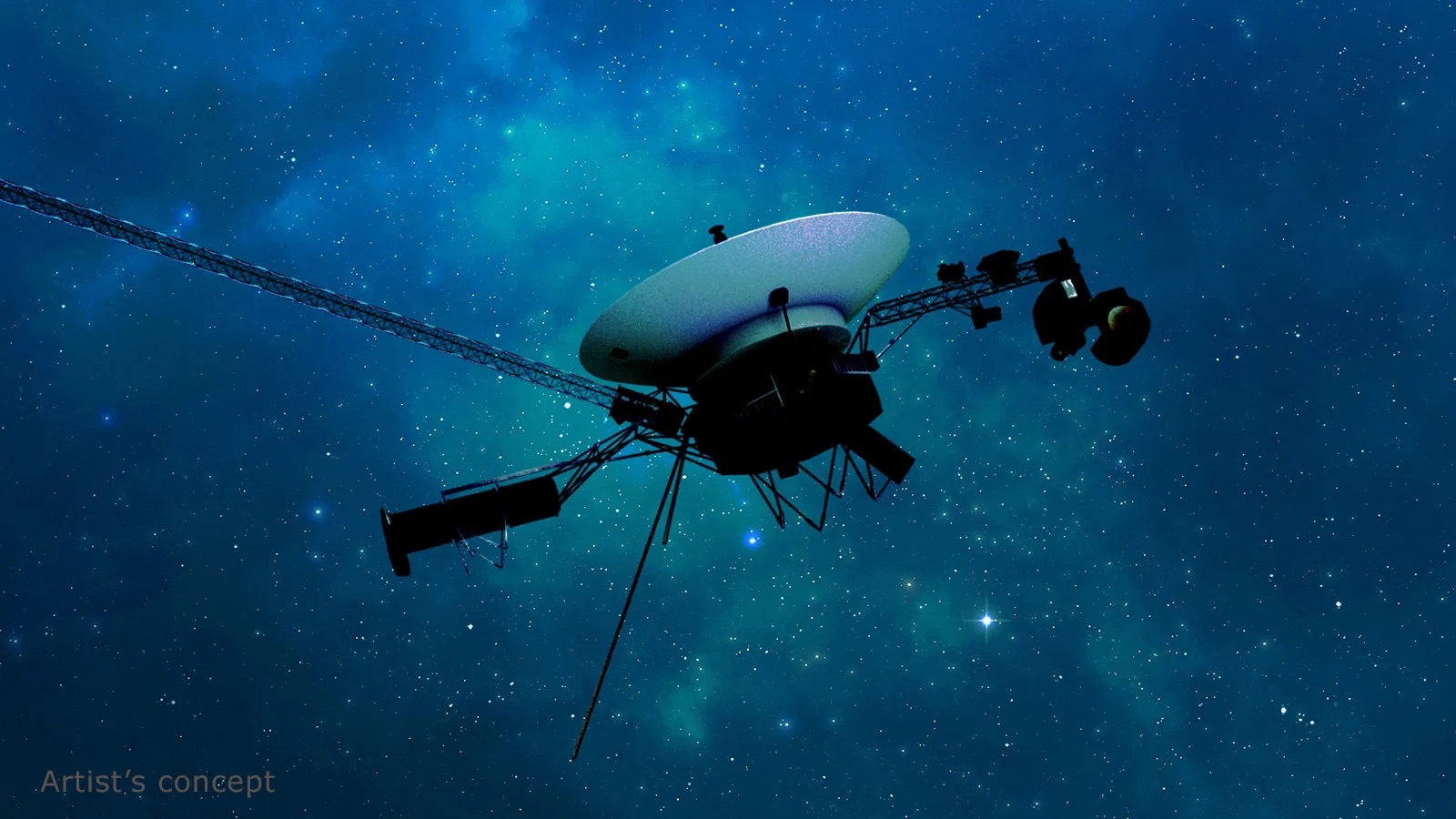
NASA’s Voyager Team Focuses on Software Patch, Thrusters

NASA Mission Update: Voyager 2 Communications Pause
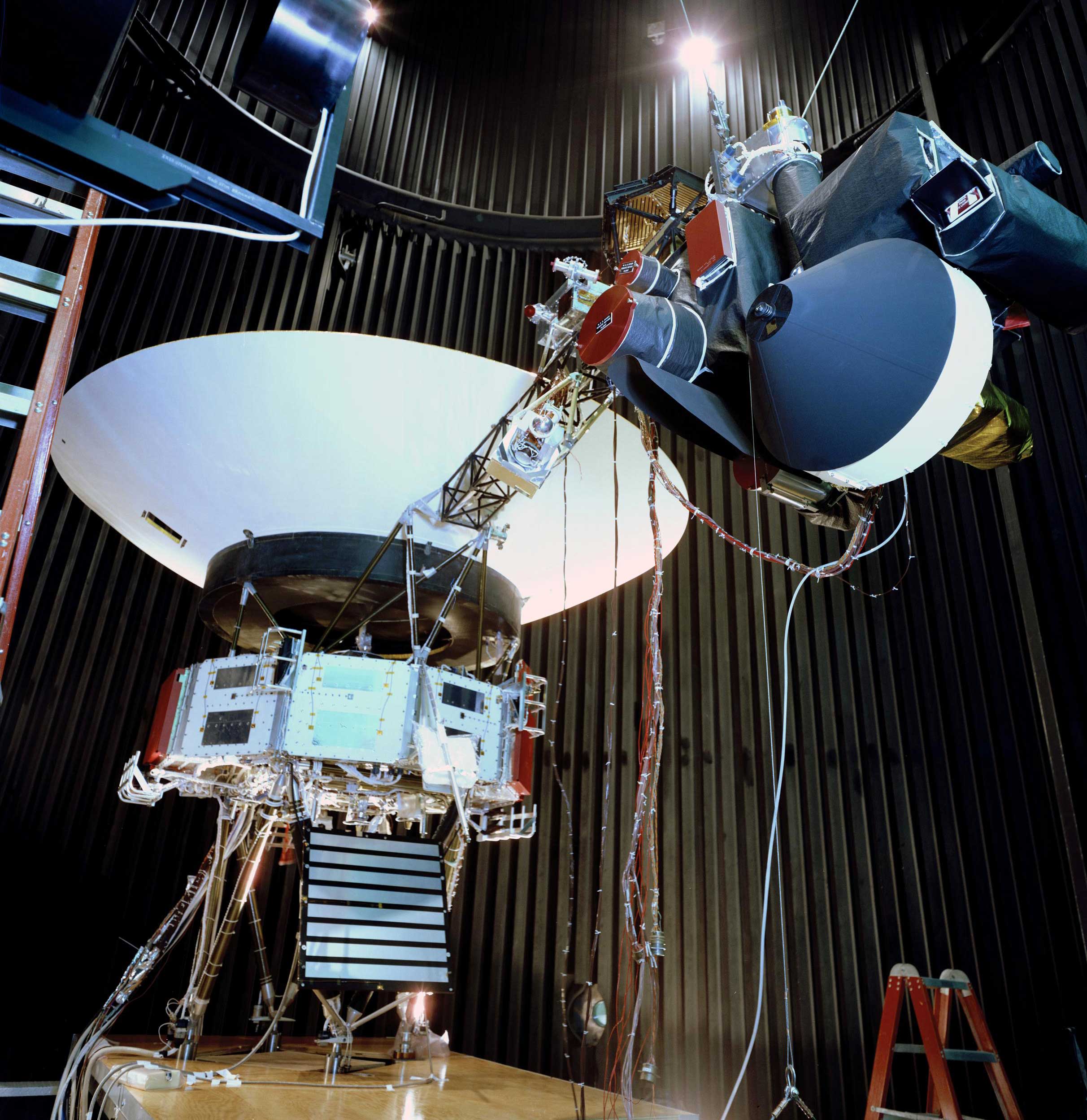
NASA's Voyager Will Do More Science With New Power Strategy
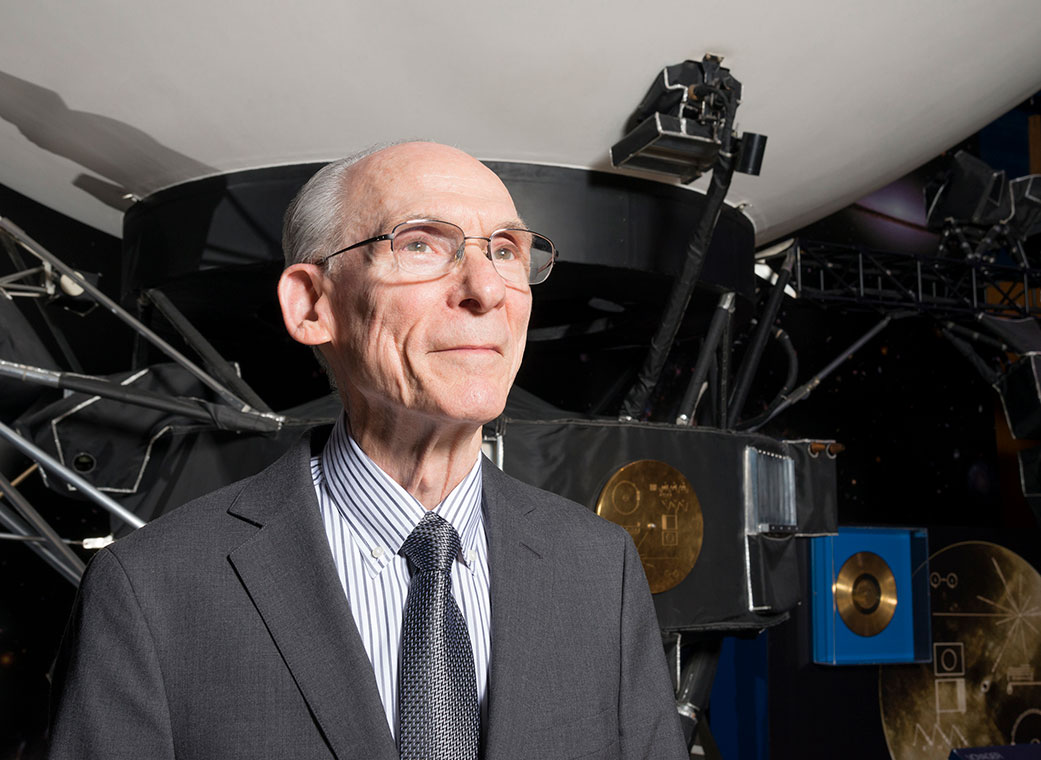
Edward Stone Retires After 50 Years as NASA Voyager's Project Scientist
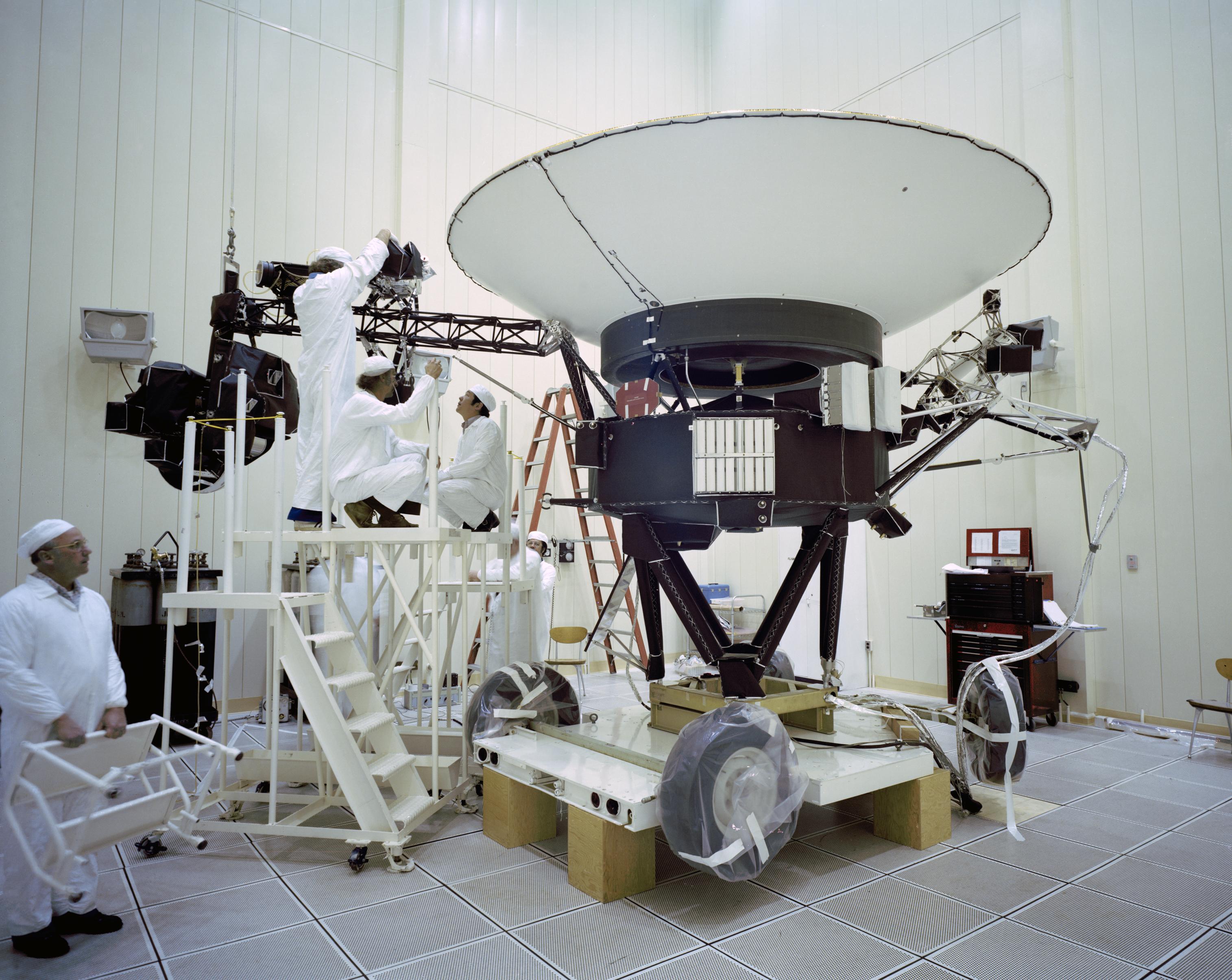
Voyager, NASA's Longest-Lived Mission, Logs 45 Years in Space
Voyager 1 distance from earth, voyager 1 distance from sun, voyager 1 one-way light time, voyager 1 cosmic ray data, voyager 2 distance from the earth, voyager 2 distance from the sun, voyager 2 one-way light time, voyager 2 cosmic ray data, what's happening now.
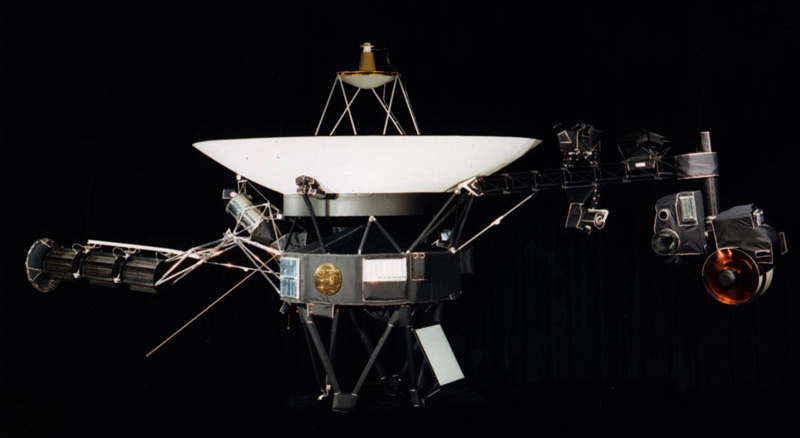
Since November 2023, NASA’s Voyager 1 spacecraft has been sending a steady radio signal to Earth, but the signal does not contain usable data.
Engineers are working to resolve an issue with one of Voyager 1’s three onboard computers, called the flight data system (FDS).
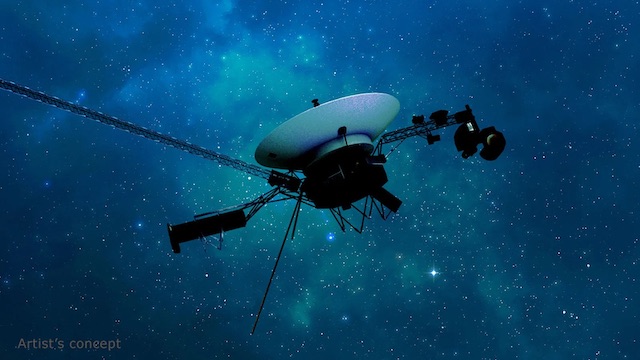
The efforts should help extend the lifetimes of the agency's interstellar explorers.

Download the Voyager 40th Anniversary posters.
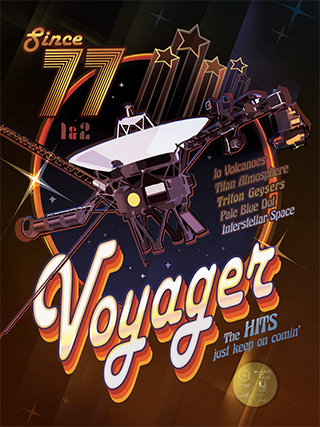
Voyager 1 Exits Heliosphere
- Released Friday, November 1, 2013
- voyager1_exits_heliosphere_cal_print.jpg (1024x576) [59.6 KB]
- voyager1_exits_heliosphere_cal.png (4200x3300) [1.5 MB]
- voyager1_exits_heliosphere_web.png (320x180) [171.7 KB]
- voyager1_exits_heliosphere_thm.png (80x40) [12.1 KB]
Presentations
- voyager1_exits_heliosphere.key [5.1 MB]
- voyager1_exits_heliosphere.pptx [736.4 KB]
Artist's concept depicts Voyager 1 entering the interstellar medium.
For More Information
See the following sources:
- http://eospso.gsfc.nasa.gov/publications/25
- http://voyager.jpl.nasa.gov
- Interstellar Medium
Please give credit for this item to: NASA/Jet Propulsion Laboratory-Caltech/The University of Iowa
Project support
- Mark Malanoski (Global Science and Technology, Inc.)
- Heather Hanson (Global Science and Technology, Inc.)
Release date
This page was originally published on Friday, November 1, 2013. This page was last updated on Tuesday, November 14, 2023 at 12:25 AM EST.
- SMD 2014 Calendar images
You may also like...
No results., an error occurred. please reload this page and try again..

IMAGES
VIDEO
COMMENTS
In the NASA Eyes on the Solar System app, you can see the real spacecraft trajectories of the Voyagers, which are updated every five minutes. Distance and velocities are updated in real-time. For a full 3D, immersive experience click on View Voyagers link below to launch the NASA Eyes on the Solar System app. View Voyager
Mission Overview. The twin Voyager 1 and 2 spacecraft are exploring where nothing from Earth has flown before. Continuing on their more-than-40-year journey since their 1977 launches, they each are much farther away from Earth and the sun than Pluto. In August 2012, Voyager 1 made the historic entry into interstellar space, the region between ...
For the past 30 years, NASA's Voyager twins have phoned home everyday, sending snapshots and stories that shaped our view of the solar system. Voyager at 40: Keep Reaching for the Stars. In the late summer of 1977, NASA launched the twin Voyager spacecraft. These remote ambassadors still beam messages back to Earth 40 years later, with data ...
A poster of the planets and moons visited during the Voyager program. The Voyager program is an American scientific program that employs two interstellar probes, Voyager 1 and Voyager 2.They were launched in 1977 to take advantage of a favorable alignment of the two gas giants Jupiter and Saturn and the ice giants, Uranus and Neptune, to fly near them while collecting data for transmission ...
For the first time since November, NASA's Voyager 1 spacecraft is returning usable data about the health and status of its onboard engineering systems.The next step is to enable the spacecraft to begin returning science data again. The probe and its twin, Voyager 2, are the only spacecraft to ever fly in interstellar space (the space between stars).
For the first time in five months, NASA has received usable data from Voyager 1, the farthest spacecraft from Earth. The aging probe, which has traveled more than 15 billion miles into space ...
Voyager 1 and its twin Voyager 2 are the only spacecraft ever to operate outside the heliosphere, the protective bubble of particles and magnetic fields generated by the Sun. Voyager 1 reached the interstellar boundary in 2012, while Voyager 2 (traveling slower and in a different direction than its twin) reached it in 2018. Mission Type.
The twin spacecraft Voyager 1 and Voyager 2 were launched by NASA in separate months in the summer of 1977 from Cape Canaveral, Florida. As originally designed, the Voyagers were to conduct closeup studies of Jupiter and Saturn, Saturn's rings, and the larger moons of the two planets.
All NASA News; Video Series on NASA+; Podcasts; Blogs; Newsletters; Social Media; Media Resources; Upcoming Launches & Landings; Virtual Events; Multimedia. NASA+; Images; NASA TV; ... NASA's Voyager Will Do More Science With New Power Strategy. Article. 7 Min Read. NASA Missions Study What May Be a 1-In-10,000-Year Gamma-ray Burst.
NASA. Sep 12, 2013. RELEASE 13-280. NASA's Voyager 1 spacecraft officially is the first human-made object to venture into interstellar space. The 36-year-old probe is about 12 billion miles (19 billion kilometers) from our sun. New and unexpected data indicate Voyager 1 has been traveling for about one year through plasma, or ionized gas ...
Jet Propulsion Laboratory, Pasadena, Calif. 626-808-2469. [email protected]. 2023-059. The plan will keep Voyager 2's science instruments turned on a few years longer than previously anticipated, enabling yet more revelations from interstellar space.
Voyager 1 flew within 64,200 kilometers (40,000 miles) of the cloud tops, while Voyager 2 came within 41,000 kilometers (26,000 miles). Saturn is the second largest planet in the solar system. It takes 29.5 Earth years to complete one orbit of the Sun, and its day was clocked at 10 hours, 39 minutes.
Rockets aren't the only thing we launch. Welcome to our improved NASA website! If you don't find what you are looking for, please try searching above, give us feedback , or return to the main site . Stay up-to-date with the latest content from the Voyager mission team as the spacecraft travel farther into interstellar space.
The Voyagers have set numerous records in their unparalleled journeys. In 2012, Voyager 1, which launched on Sept. 5, 1977, became the only spacecraft to have entered interstellar space. Voyager 2, launched on Aug. 20, 1977, is the only spacecraft to have flown by all four outer planets - Jupiter, Saturn, Uranus and Neptune.
A series of planned commands sent to NASA's Voyager 2 spacecraft July 21 inadvertently caused the antenna to point 2 degrees away from Earth. As a result, Voyager 2 is currently unable to receive commands or transmit data back to Earth. ... The Voyager missions are a part of the NASA Heliophysics System Observatory, sponsored by the ...
The Von Kármán Lecture Series: Voyager: 45 Years in Space. As the twin Voyager spacecraft approach their 45th anniversary, we take a look at where the mission has been, what they've taught us, and where they go from here. In this conversation with Suzanne Dodd, Voyager Project Manager, we'll discuss how Voyager came to be, highlight some ...
JPL manages the Voyager Project for NASA's Office of Space Science and Applications. 818-354-5011. 1987-1155. With one of its two spacecraft en route to distant Neptune and the other exploring the outer solar system, the Voyager Mission celebrates its 10th anniversary of launch on Aug. 20.
Since its launch from Kennedy Space Center on Sept. 5, 1977, NASA's Voyager 1 spacecraft has diligently sent regular updates to Earth on the health of its systems and data collected from its ...
For the first time since November, NASA's Voyager 1 spacecraft is returning usable data about the health and status of its onboard engineering systems. The next step is to enable the spacecraft to ...
NASA's Jet Propulsion Laboratory in Southern California declared success after receiving good engineering updates late last week. The team is still working to restore transmission of the science data. It takes 22 1/2 hours to send a signal to Voyager 1, more than 15 billion miles (24 billion kilometers) away in interstellar space.
NASA says it is once again able to get meaningful information back from the Voyager 1 probe, after months of troubleshooting a glitch that had this venerable spacecraft sending home messages that ...
The last two spacecraft of NASA's Mariner series, Voyager 1 and 2 were the first in that series to be sent to explore the outer solar system. Preceeded by the Pioneer 10 and 11 missions, Voyager 1 and 2 were to make studies of Jupiter and Saturn, their satellites, and their magnetospheres as well as studies of the interplanetary medium.
August 2022 - Voyager - 45 Years in Space. This artist's concept depicts NASA's Voyager 1 spacecraft entering interstellar space. Interstellar space is dominated by the plasma, or ionized gas, that was ejected by the death of nearby giant stars millions of years ago. Credit: NASA/JPL-Caltech. Full Image Details.
April 22 (UPI) --The pioneering Voyager 1 deep-space probe is once again sending usable engineering updates back to Earth after five months of repairs, NASA officials announced Monday. Voyager 1 ...
This is a real-time indicator of Voyager 1's distance from Earth in astronomical units (AU) and either miles (mi) or kilometers (km). Note: Because Earth moves around the sun faster than Voyager 1 is speeding away from the inner solar system, the distance between Earth and the spacecraft actually decreases at certain times of year.
The Pale Blue Dot is a photograph of Earth taken Feb. 14, 1990, by NASA's Voyager 1 at a distance of ...[+] 3.7 billion miles (6 billion kilometers) from the sun. The image inspired the title of ...
At 122 times our distance from the sun, NASA's Voyager 1 spacecraft is the first human-made object to leave the heliosphere, the far-reaching extended atmosphere of the sun. Launched in 1997, Voyager 1 is traveling away from Earth at a speed of about 340 million miles (540 million kilometers) per year. In the summer of 2012, Voyager 1 started its journey into interstellar space, or the space ...